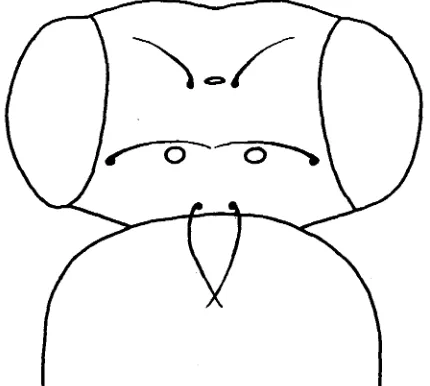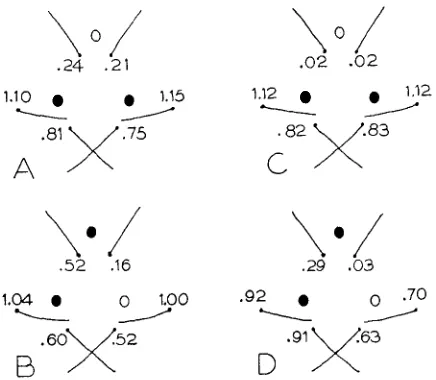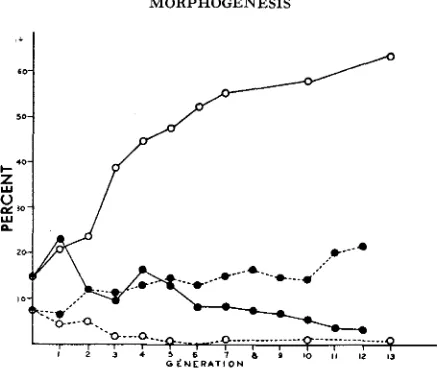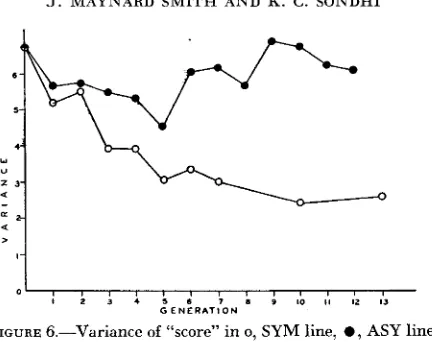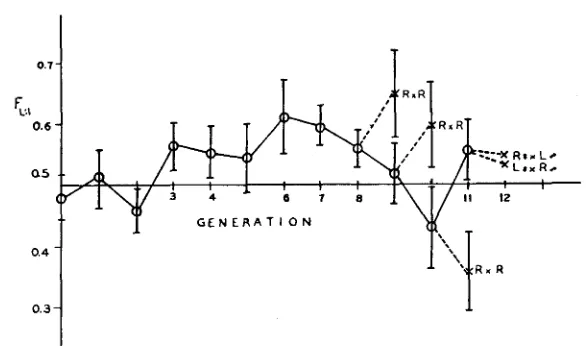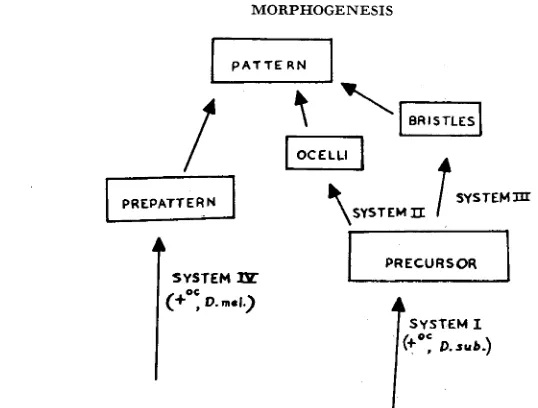THE
GENETICS OF A PATTERN J. MAYNARD SMITH AND K. C. SONDHI Department of Zoology, Uniuersity College, London, EnglandReceived January 27, 1960
aper is concerned with the problem of the genetic control of morpho- T::2ezs. Previous attacks on this problem have usually taken, as their starting point, some single mutant gene with well-marked morphological effects, and an attempt has been made to derect the earliest effect of this gene. A second approach has been through the study of mosaics (STERN 1954, 1956). The techniques used in this paper are mainly those of quantitative genetics; a n attempt has been made to deduce the nature of the developmental processes and their genetic control by studying the range of variation in the end products of these processes, that is, by studying adult variation. I t is thus an extension of the line of thought which has led WADDINGTON ( 1942) to suggest processes of epigenetic canalization. Although a major mutant gene, ocelliless, has been used in our experiments, this gene has been not so much an object of study in itself as a source of observable variation: a n environmental shock during development causing comparabje variation would have served equally well.
The pattern chosen for study (Figure 1 ) was that of the three ocelli and the three pairs of associated bristles: the ocellar setae, anterior vertical setae and postvertical setae, lying in the anterior, middle and posterior region of the head respectively. The arrangement of macrochaetae and ocelli shown in the figure
1040 J . M A Y N A R D S M I T H A N D K . C. S O N D H I
is common to all the species of Drosophila we have examined, although various mutants are known which modify it. In
D.
subobscura the sex-linked recessive gene ocelliless removes most of the nine structures shown in most individuals. I n the original outbred mutant stock, nearly half the individuals lacked all nine structures, and only one individual out of over 800 was found with all of them. I n the remaining individuals, one or more of the ocelli or bristles were present, approximately in their normal positions, the remaining structures being absent. Starting from this population, SONDHI (1960) was able, by breeding from indi- viduals with the greatest number of structures, to obtain a population which, although still carrying the mutant, contained a high proportion of wild-type individuals. I n the present experiment, an attempt has been made to produce by selection populations in which a high proportion of individuals have an inter- mediate pattern with some but not all of the structures present. Two such experiments have been performed, one by breeding from individuals with the two posterior ocelli but lacking the anterior one, and the other by breeding from individuals with the anterior and the left posterior ocelli, but lacking the right posterior ocellus. From the response of the original population to these two types of selection, it has been possible to suggest a hypothesis concerning the genetic control of the wild-type pattern.E X P E R I M E N T A L PROCEDURE
The foundation population: As a starting point, a population with a fair
proportion of individuals with two ocelli was required. This was obtained by crossing several of SONDHI’S (1960) selected lines (the U
x
U line, which hadbeen selected for the presence of the maximum number of structures, and the two reciprocally selecetd U x D and D x U lines). Seven hundred and seventy-three flies from this foundation population were classified, the presence or absence of each structure being recorded for each individual. Not uncommonly the anterior vertical bristles were repeated, on one or both sides; these repetitions were also recorded.
M ORPHO GE NESIS 1041
8 '0
FICUHE 2.-Frequency distributions of phenotypes in ( a ) the foundation population; (b) a line selected for the wild-type phenotype, SONDHI (1960).
There was a correlation between the presence of bristles and ocelli, as indicated by the ridge running from the positions two bristles, zero ocelli to six bristles, three ocelli. SONDHI (1960) found this correlation to be of general occurrence, so that the same factors, genetic or environmental, which increase the number of bristles, tend also to increase the number of ocelli. This correlation is local as well as general, in that if only some of the ocelli are present, the bristles close to these ocelli are more likely to be present than are the more distantly situated bristles. This point is illustrated in Figure 3.
In ocelliless populations the bristles and ocelli, if present, may be slightly displaced from their normal positions. But in the populations described in this paper the various structures were never displaced to such a n extent as to make their identification impossible. There are also variations in the size of the ocelli and, to a less extent, of bristles. These variations have been ignored, but an at- tempt has been made to be consistent in the scoring of presence and absence.
Selection procedure: Two selected lines, SYM (symmetrical) and ASY (asym-
metrical) were maintained.
I n the SYM line, only flies with the two posterior ocelli, but lacking the anterior ocellus, were used as parents. Bristles were ignored in the selection of parents. Ten to 12 cultures, with three parents of each sex, were set up in each generation; matings between flies from the same culture were avoided. Selection was continued for 13 generations. Approximately 400 flies (20 males and 20 females from each culture) were classified in each generation. Generations 8, 9, 11 and 12 were not classified, although selection was practiced on them.
1042 3 . M A Y N A R D S M I T H AD-D K. C. S O N D H I
\ O i .24 .21 \ O / .02 .02
1.10 1.12
----
.81x?
A
C
1.10 1.12
----
.81x?
A
C
\ @ .52
/
.16\./
.29 .03FIGURE 3.-Frequencies of bristles in (A) 114 flies in the foundation population having the two posterior ocelli only; (.B) 25 flies in the foundation population having the anterior and left posterior ocelli only; (C) 268 flies in the SYM S-13 having the two posterior ocelli only; (D) 70 flies in the ASY S-12 having the anterior and left posterior ocelli only. The frequency is equal to the number of bristles divided by the number of flies; since the vertical setae are sometimes duplicated, their frequency can be greater than unity.
lacking the right posterior ocellus, were used as parents. Bristles were ignored in selecting parents in the early generations since only a few flies with the re- quired phenotype were available, but in later generations preference was given to flies with more bristles on the left than the right side. Ten to 12 paired matings were set up in each generation, avoiding brother-sister matings. Selection was continued for 12 generations, the number of flies classified varying from 274 to 902.
R E S U L T S
The response of the two lines to selection is shown in Figure 4. The combined frequency of flies with the anterior and right and with the anterior and left ocelli only has been plotted, instead of the latter frequency alone, since, as will he shown, there was no continued trend towards handedness, so that the com- bined frequency gives a more accurate estimate of the changes occurring.
MORPHOGENESIS 104.3
FK"m.-Frequencies of phenotypes in the selected lines. Full lines, frequency of flies with the two posterior ocelli only; broken lines, combined frequency of flies with the anterior and left and with the anterior and right posterior ocelli only; 0, SYM line, 0 , ASY line.
\ OL' b
FIGURE 5.-Frequency of distribution of phenotypes in ( a ) the SYM line, S-13; ( b ) the ASY line, S-12.
the "canalization" of a phenotype other than the wild type. There was a tend- ency for the rate of response to decline in later generations, but this merely reflects the reduced intensity of selection in these generations when about half the flies had the desired phenotype.
1044 J . M A Y N A R D SMITH A N D K. C. S O N D H I
I 2 3 4 5 6 7 ~ 9 1 0 1 1 I 2 I J
G E N E R A T I O N
FIGURE 6.-Variance of “score” in 0, SYM line, 0 , ASY line.
single clear frequency peak. For reasons given below, the frequency of individu- als with only one ocellus is low so that there is a valley separating two small peaks at one bristle, zero ocelli and at four bristles, three ocelli.
This contrast between the canalization of a single phenotype in the SYM line, and the absence of such canalization in the ASY line, can be shown in another way (Figure 6 ) . Each individual has been given a ‘Lscore” equal to the sum of the numbers of ocelli and bristles present and the variance of this score calculated for each generation of each line. There was no significant decline in the variance of the ASY line, whereas in the SYM line, the variance fell to less than half its initial value.
Although the ASY line remained variable, there was a threefold increase in the frequency of the selected phenotype. The nature of the changes in the population responsible for this increase can be analyzed as follows:
let FAL, FAR = frequencies, respectively, of individuals with the anterior and
F , = frequency of individuals with only one posterior ocellus.
FL FR
,
= proportions of individuals having only one posterior ocellus which have, respectively, the left and the right ocellus; F;,+
FR,
= 1.F A L , F , = proportion of individuals having, respectively, the left and the
right ocellus, which have also the anterior ocellus.
F A = proportion of individuals having only one posterior ocellus, which have also the anterior ocellus. (In all populations studied, FA 1 e F A L E F A R ) .
F , , FE = frequencies, respectively, of individuals having the left and the
right ocellus, independently of the presence of other ocelli. FA L R = proportion of individuals having both posterior ocelli, which have
also the anterior ocellus.
r = correlation between the presence of the right and of the left ocellus. left, and with the anterior and right ocelli only.
Then the frequency of individuals with the selected phenotype is: F A L = F ~ X F L ~ X F A ,
MORPHOGENESIS 1045
Hence an increase in the frequency of the selected phenotype, F A L , can result from a n increase in F , (an increase in asymmetry), or in FL
,
(an increase in left- handedness), or in FA., (a symmetrical change, increasing the frequency of the anterior ocellus).Table 1 shows some values of these frequencies. It shows that the increase in the frequency of the selected phenotype in the ASY line was almost entirely due to an increase in F.1 There was a corresponding decrease in F A
,
in the SYM line. Similarly, F.4 L R increased in the ASY line and decreased in the SYM line.In other words, the main change in the ASY line was an increase in the frequency of individuals with the anterior ocellus-the opposite change to that which occurred in the SYM line. Consequently, the frequency of individuals with only one posterior ocellus and no anterior ocellus, F , (1
-
FA.,),
declined in the ASY line, so that, as shown in Figure 5b, there are few flies with only one ocellus.But the table suggests that changes in handedness and in asymmetry may also have occurred in the ASY line: these possibilities will be considered in turn.
Handedness: Figure 7 shows the changes in F L , I j the frequency of left-handed
individuals as a fraction of all handed individuals, in the ASY line. For the first seven generations, there was an increase in the proportion of left-handed indi- viduals, but this tendency was not maintained. I n the eighth, ninth and tenth generations individuals with the anterior and right ocelli only were selected from the line and mated together: the values of FL
,
in their offspring are shown in the figure. In the 11th generation, matings were made of females with front and right ocelli to males with front and left ocelli, and reciprocally; values of F L . 1 for the offspring of these crosses are also shown. It will be seen that despite the apparent early trend towards left-handedness, later experiments failed to demonstrate the presence of consistent genetic or maternal effects on handedness. The explanation of these results is not clear. It seems likely that the handednessTABLE 1
Frequencies of phenotypes following selection
Conelation lietween
Numher posterior Frequencies
of flies ocelli F P
n T Fl F L . 1 F A . , F*.LR = x ( F L + F R I
Foundation
population 773 0.44 0.255 0.482 0.284 0.715 0.643
S-8 902 0.44 0.282 0.561 0.587 0.805 0.529 ASY S-11 361 0.41 0.282 0.560 0.726 0.918 0.609 s-12 592 0.43 0.280 0.542 0.777 0.915 0.583
s-7 465 0.48 0.137 0.468 0.047 0.277 0.843
1046
0.1
1
J . M A Y N A R D SMITH A N D K. C. S O N D H I
T
F,,
0.6
a5
0.4
I
FIGURE 7.-Values of F , 1, the proportion of flies having only one posterior ocellus which
have the Iefl ocellus, in the ASY line; the vertical lines represent standard errors.
of individuals is a purely chance phenomenon in the sense that it is not influenced either genetically or maternally.
Asymmetry: If there is no significant handedness in the population, then
F L = F , = F p , say. It is easy to show that F,, the frequency of asymmetrical animals, is given by F , = 2 F , (1 - F p ) (1 - r ) .
Table 1 shows that r did not change in either line. r measures the relative importance of factors affecting the two posterior ocelli in common to the factors affecting the two ocelli independently.
0.28. The value of F , is not very sensitive to changes in F , from about 0.4 to 0.6;
for F , = 0.4 or 0.6, F , = 0.269.
The table shows that in the foundation population the value of F , = 0.643 was too high to give the maximum value of F,. In SYM line, F , rose further, with a corresponding decline in F , . In the ASY line, F , fell to between 0.5 and 0.6,
and F , rose to 0.28 which is the maximum possible without a reduction in r.
Thus, although there was a slight increase in the frequency of asymmetrical flies in the ASY line and a large decrease in this frequency in the SYM line, these changes were the consequences of a symmetrical change, that is, of a change in F,> affecting both posterior ocelli equally.
In conclusion, the increase in the frequency of the selected phenotype in the ASY line was the consequence of two symmetrical changes, the first and most important being a n increase in the frequency of the anterior ocellus, and the second (and less important) a decline in the frequency of the posterior ocelli nearly to the optimum value of 0.5.
If r is constant. then F , is a maximum when F p 1 0 . 5 . For r 0.44, F,,,,
DISCUSSION
M ORPHO GE NESI S 1047
SYSTEM Z
(+O: D.m.1.)
FIGURE &-Genetic control of the ocellar pattern.
System I is responsible for the formation of a common “precursor” of both ocelli and bristles; this precursor must be distributed in adequate amounts over the region where the pattern is formed. (It should be emphasized that this precursor is hypothetical; it might be better to talk of the distribution of com- petence to form bristles and ocelli.)
Systems I1 and I11 are responsible for the formation of ocelli and bristles respectively, given that the necessary common precursor is present.
System IV specifies the position at which ocelli and bristles are formed; this corresponds to what STERN (1954, 1956) has called a “prepattern.”
Both ocelli and bristles are derivatives of the hypodermis, so it is reasonable to postulate a common precursor. BIRMINGHAM (1942) has shown that cephalic imaginal discs, implanted in the body cavity, commonly develop the bristles and ocelli appropriate to the side of the head from which the implant was taken, including a small median ocellus, probably corresponding to half the normal anterior ocellus. It follows that the symmetrical pattern of adult flies arises from the bringing together of two asymmetrical half-patterns, and that the capacity to form a “prepattern” is a property of the imaginal discs themselves.
1048 J . M A Y N A R D S M I T H A N D K. C. S O N D H I
This account oversimplifies the situation in one respect: the ocelliless mutant
in D . subobscura does have some effect on the prepattern. The bristles, and much
more rarely the ocelli, may be duplicated. Often the structures are slightly dis- placed, and very occasionally an additional bristle occurs i n an atypical site. But the present selection experiments have altered the distribution of the pre- cursor rather than the prepattern. This conclusion is drawn because in the SYM line, in those flies which did have three ocelli, the anterior ocellus was usually reduced in size, often to a small speck, but was not displaced posteriorly.
SONDHI’S ( 1960) experiments showed that selection in ocelliless populations could alter the amount of precursor in either direction. In other words, it was possible to select a polygenic system capable in large measure of performing the function normally performed by the +OC allele. The present experiments show that it is also possible to alter the distribution of the precursor along the antero- posterior axis. In the SYM line, the precursor was concentrated at the back of the head, whereas in the ASY line the amount of precursor posteriorly was
slightly reduced to the level which gave a probability of approximately 0.5 for the development of a given posterior ocellus and, hence, the maximum chance for the development of an asymmetrical individual.
The failure to alter r, the correlation between the posterior ocelli, or to produce any marked degree of handedness suggests that the distribution of the precursor along a lateral axis was not under genetic control. This is not surprising. The alteration of the antero-posterior distribution of the precursor during develop- ment probably depends on the existence earlier in development of antero- posterior gradients in the head region. There are probably no corresponding lateral gradients in the head of developing Drosophila since the adult structure is symmetrical.
If this interpretation is accepted, it follows that the success in reducing the phenotypic variance in the SYM line depended on the effectiveness of directional
selection in favour of genes concentrating the precursor posteriorly and on the presence of the prepattern; it did not depend on “normalizing” selection (WAD- DINGTON 1957) in favour of intermediates for a single quantitative character.
Such normalizing selection is usually relatively ineffective in altering a popula- tion (FALCONER and ROBERTSON 1956; ROBERTSON 1956). To use a homely analogy between the distribution of phenotypes in a population and the dis- tribution of dust on a floor, our experiment demonstrates the effectiveness of brushing in a single direction, corresponding to directional selection, used in combination with a dustpan, corresponding to the existence of a constant prepat- tern in all members of the population.
MORPHOGENESIS 1049
point the analysis by TURING (1952) of the origin of chemical instabilities in a n initially homogeneous field. Experimentally, it is hoped that something may be learned about the genesis of the ocellar pattern by selection which concentrates on the displacements of the ocelli and bristles, rather than on their presence or absence.
SUMMARY
The mutant ocelliless in Drosophila subobscura affects the three ocelli and three pairs of bristles on the top of the head. I n most flies homozygous for the mutant, one or more of these nine structures are absent, but if present, the structures are approximately in their normal positions.
This paper describes the changes in two selected lines homozygous for the mutant. I n the SYM (symmetrical) line, flies with the two posterior ocelli only were selected as parents; in the ASY (asymmetrical) line, flies with the anterior and left posterior ocelli only were selected as parents.
The results can be explained if it is assumed that the wild-type pattern depends on two genetic systems, the first responsible for a “prepattern” determining the positions of the ocelli and bristles, and the second for the formation of a common “precursor” of ocelli and bristles. The wild-type allele of oc forms part of the second system, so that in ocelliless flies the precursor is abnormal in amount and distribution. Selection can alter the amount of precursor, and its distribution along an antero-posterior gradient, but cannot modify its distribution along a gradient from left to right.
Consequently the SYM line contained a high proportion of individuals with the two posterior ocelli and the two posterior pairs of bristles only, due to a concentration of the precursor posteriorly. But in the ASY line, selection did not alter either the correlation between the presence of the left and right ocelli, or the relative frequency of flies with the left as compared with the right ocellus only. Therefore, although there was a threefold increase in the frequency of the selected phenotype in the ASY line, this was the result of symmetrical changes in the distribution of the precursor.
ACKNOWLEDGMENT
This work was supported by a grant from the Nuffield Foundation, whose assistance is gratefully acknowledged.
LITERATURE CITED
BIRMINGHAM, L., 194.2 Boundaries of differentiation of cephalic imaginal discs in Drosophila. J.
Selection for environmental variability of body size Exptl. Z00l. 91 : 346-363.
FALCONER, D. S., and S. ROBERTSON, 1956 in mice. Z. Ind. Abst. Vererb. 87: 385-391.
MAYNARD SMITH, J., 1960 Continuous, quantised and modal variation. Proc. Roy. Soc. London B
1050
ROBERTSON, A., 1956
SONDHI, K. C., 1960
STERN, C., 1954
J . M A Y N A R D S M I T H A N D K . C. S O N D H I
The effect of selection against extreme deviants based on deviation or on
Selection for a character with a bounded distributoin of phenotypes in
Genes and developmental patterns. Proc. 9th Intern. Congr. Genet. 6: 355-369. The genetic control of developmental competence and morphogenetic tissue interactions
The chemical basis of morphogenesis. Phil. Trans. Roy. Soc. London. Ser.
Canalization of development and the inheritance of acquired char- homozygosis. J. Genet. 54: 236-248.
Drosophila subobscura. J. Genet. (in press).
1956
in genetic mosaics. Arch. Entwicklungsmech. Organ. 149 : 1-25.
B 237: 37-72.
TURING, A. M., 1952
WADDINGTON, C. H., 1942 acters. Nature 150: 563-565.
